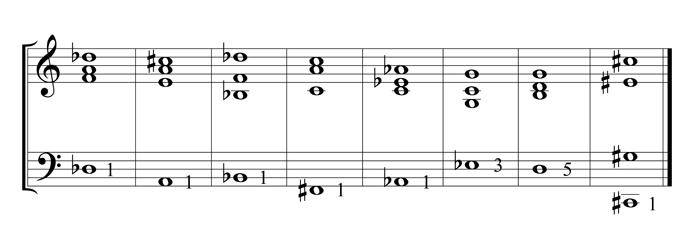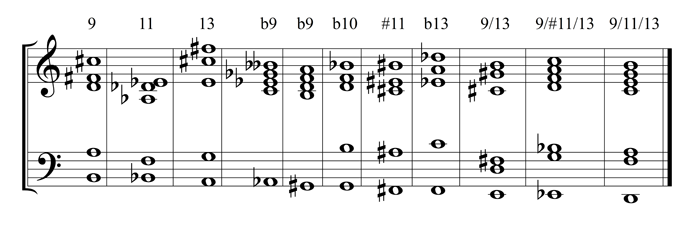Professional preparatory music theory: Basic elements of music theory.
Chapter 3 of the Basic elements of music theory – by Oscar van Dillen ©2014-16
The advanced learning book can be found at Outline of basic music theory.
Building blocks of harmony – part 3: Chords
Pages and chapters:
Chapter 1: Introduction
Chapter 2: Musical notation
Chapter 3: Building blocks of harmony – Scales
Chapter 4: Building blocks of harmony – Intervals
Chapter 5: Building blocks of harmony – Chords
Chapter 6: Keys and key signatures
Chapter 7: Further study
Chords
- A chord is the harmonic relationship between 3 or more tones.
A harmonic relationship is heard when tones are sounding together, which is also possible when some or all of the tones are not being played simultaneously.
Triads
- A triad is a special chord-type, consisting of three different tones, and of three intervals: two thirds and one fifth (or inversions or wide versions of just these intervals).
A triad can also contain more than three tones, by unison- or octave-doubling of the three different tones. In the following paragraphs such positions are not used; instead, simple three-note positions are presented to allow the student an overview of the underlying structures of the triads.
The basic structure of any triad can be summarized as 1 – 3 – 5
Major and minor triad
The two most commonly used chords are the major and the minor triad. Both have a perfect fifth so are considered consonant, but the difference between the two lies in the lower third (examples are all on and of c) :
- C – major chord, or major triad
- Cm – minor chord, or minor triad

example 27 – major and minor triad
Note that both perfect fifths consist of two thirds, one major and one minor third.
EXERCISES 9
- Notate the major and minor triads on c, d, e, f, g, a and b, in simple three-tone root positions;
- Read and sing all these triads tone by tone, both upwards and downwards;
Diminished and augmented triad
The most commonly used dissonant chord is the diminished triad, consisting of a minor third and a diminished fifth. A less common basic chord is the augmented triad, consisting of a major third and an augmented fifth (examples are all on and of c) :
- Cdim – diminished triad
- Caug – augmented triad

example 28 – diminished and augmented triad
Note that these dissonant triads contain twice a minor and twice a major third respectively.
EXERCISES 10
- Notate diminished and augmented triads on c, d, e, f, g, a and b, in simple three-tone root positions;
- Read and sing all these triads tone by tone, both upwards and downwards;
Seventh chords
Seventh chord are based on triads and contain one more tone, added as a third above the fifth of the underlying triad.
The basic structure of any seventh chord can be summarized as 1 – 3 – 5 – 7
Below are listed the most commonly used seventh chords, with the underlying triad mentioned below and the added seventh after and above (examples are all on and of c) :
- C7 – called dominant seventh chord, consists of a major triad with an added minor seventh
- Cdim7 – called diminished seventh chord, consists of a diminished triad with an added diminished seventh
- Cm7b5 – called half diminished chord, consists of a diminished triad with an added minor seventh
- Cm7 – called minor seventh chord, consists of a minor triad with an added minor seventh
- Cmaj7 – called major seventh chord, consists of a major triad with an added major seventh

example 29 – basic seventh chords
In the chord examples above, chord symbols were used as abbreviations for the full chord names.
EXERCISES 11
- Notate the five basic seventh chords on c, d, e, f, g, a and b, in simple four-tone root positions;
- Read and sing all these seventh chords tone by tone, both upwards and downwards;
Triads as basic degrees in major and minor
To create basic harmony and chord progressions, scales are harmonized by constructing a triad on each scale-step, using only the tones of that specific scale. Such a triad is called a degree, and music theory indicates degrees with Roman numerals.
In this way, on the major scale, three major triads (I, IV and V), three minor triads (II, III and VI) and one diminished triad (VII) appear:

example 30 – basic degrees in major
In this way, on the harmonic minor scale, two major triads (V and VI), two minor triads (I and IV), two diminished triads (II and VII) and one augmented triad (III) appear:

example 31 – basic degrees in minor
Note that the only triads which are identical in both major and minor, are the degrees V and VII.
EXERCISES 12
- Notate the seven basic degrees as triads on the other major and harmonic minor scales, in simple three-tone root positions;
- Read and sing all these degrees tone by tone and step by step, both upwards and downwards;
Basic 4-voice positions of triads
There are many ways triads can be played. Most certainly, the way they are represented in the above explanations is not a usual way they will be actually performed. The above notations are intended to allow the student a clear insight into their inner structure and mutual coherence.
When studying basic harmony, triads are usually notated with four tones each, which is called a four voice setting. The names of these four voices follow the voice names in a mixed choir: soprano, alto, tenor and bass.
Below are some examples of 4-voice positions of triads, notated on a piano staff-system which could also be sung by a mixed choir. Added to the bass are the numbers of its tones within the triad. In most cases the bass contains the root or 1; these are called root positions. In two of the examples the third and the fifth are the lowest tones sounding; these are called inversions:

example 32 – four voice chord positions
EXERCISES 13
- Identify the type of triad and name the chords in the above example;
- Notate and play these and other such triads in various positions, then read and sing all these chords tone by tone, both upwards and downwards;
Inversions of chords
When the bass of a chord, the lowest sounding chord tone, is indeed a chord-tone but not the root (1) of the chord, the chord is in inversion. When the bass of a chord is not a chord tone at all, it contains a non-harmonic tone. In chord symbols, both cases are symbolized as slash chords.
A triad has two possible inversions, called 1st inversion or sixth position (6) and 2nd inversion or six-four position (6-4). One of each was used in example 32.
A seventh chord, containing four tones, has three possible inversions, called 1st inversion or six-five position (6-5), 2nd inversion or four-three position (4-3) and 3rd inversion or second position (2).
Suspended chord tones
Replacing one of the chord tones by another tone is called suspension. This can be done both with harmonic (chord) tones and with non-harmonic tones.
The most common suspended chord tones are the suspended fourth (sus4) and second (sus2), where the perfect fourth or the major second replace the third (major or minor) of the chord.
Inversions of such sus chords are actually other sus chords, as the example below demonstrates:

example 33 – suspended chord tones
Chord extensions
Other non-harmonic tones may be added to a chord, the most common are:
- added tones, such as add9 to a triad
- chord extensions, further extending the seventh chord in thirds with 1 – 3 – 5 – 7 – 9 – 11 – 13
- altered extensions, such as b9, b10, #11 and b13
Some examples of chord extensions are given in the example below:

example 34 – chord extensions
EXERCISES 14
- Identify and name the seventh chords in the above example;
- Sing the seventh chords and the extensions;
goto chapter 6 ► Keys and key signatures
Oscar van Dillen ©2014-16
